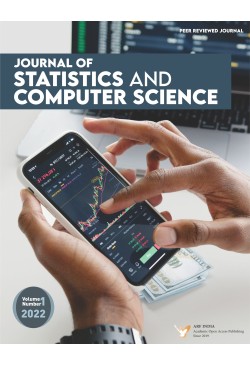JSCSJournal of Statistics and Computer Science

Peer Reviewed Journal

Peer Reviewed Journal
Improved Warning Limits Control Chart to Detect Shifts in the Process Mean
For univariate processes, Rattihalli et al. (2021-2022) proposed ‘Modified Control Chart with Warning Limits to monitor the process mean’ (MCCWL-????). Also, Gadre and Rattihalli (2022) introduced ‘Improved Control Chart to monitor the process mean’ (ICC-????). Here, we propose ‘Improved Warning Limits control chart to detect shift in the process mean’ (IWL-????) chart. It is numerically illustrated that, IWL-???? chart significantly reduces the out of control ‘Average Time to Signal’ (ATS) as compared to the ???? chart, MCCWL-???? and ICC-????.
Keywords: Control Limits, Warning Limits, Average Run Length, Average Time to Signal, MCCWL-???? and ICC-???? .
Gadre M.P., & Miss. Patel R.A. (2024). Improved Warning Limits Control Chart to Detect Shifts in the Process Mean. Journal of Statistics and Computer Science. 3(1), 1-12.
Modelling the cost of the biggest forthcoming disaster using largest values and next record in insurance
In this paper, we consider a sequence of independent and identically distributed random variables for which, for n ? 2, only the l largest values are observed (with 2 ? l ? n). For example, this is the case when the excesses over a threshold are only observed. We propose a method to calculate a prediction interval for the value of the next record of this sequence. This method is based on using linear regression models, without doing any parametric assumption on the distribution of the observed variables. The explanatory variable in these models is the rank of the order statistics related to the largest values observed. The obtained result is compared with an exact prediction interval knowing the distribution of the sequence, and with a prediction
interval calculated by using the Hill estimator and assuming that the sequence has a Pareto distribution. These comparisons are made on several simulated-data sets, and the linear model method is also applied to insurance data related to catastrophic events.
Keywords : Extremes; Records; Order statistics; Linear model; Pareto distribution.
Lucien Diégane GNING, & Daniel PIERRE-LOTI-VIAUD (2024). Modelling the cost of the biggest forthcoming disaster using largest values and next record in insurance. Journal of Statistics and Computer Science. 3(1), 13-40.
Recursive Estimation in Restricted Exponential Autoregressive Models
This study proposes a recursive estimation algorithm for the restricted exponential autore- gressive (EXPAR) model. The recursive least squares (RLS) theory is based on the matrix inversion lemma. It is shown that the RLS estimators are asymptotically e¢ cient. A short simulation study shows the high performance of the obtained estimators.
KeyWords: Restricted exponential autoregressive model, On line estimation algorithm, RLS method, The matrix inversion lemma.
Mathematics Subject Classification: 62F12; 62M10.
N. Boumaila & M. Merzougui (2024). Recursive Estimation in Restricted Exponential Autoregressive Models. Journal of Statistics and Computer Science. 3(1), 41-49.
Attrition coefficient estimations via differential equation systems, initial and terminal conditions, and nonlinear iterative equation system solutions
In battles with aimed fire, the attrition of a force can under simplified assumptions be shown to be proportional to the number of enemies. Lanchester models for aimed fire are differential equation systems that can be applied to describe the dynamics of such battles In order to determine the attrition coefficients and the complete dynamics of the battle in continuous time, the following procedure is introduced: First, the general solution of the Lanchester differential equation system, which is a homogenous second order differential equation system, is derived. The four parameters of the solution are determined. In these equations, the initial and terminal sizes of the two forces, are parameters. A 4-dimensional fix point iteration algorithm is developed and implemented as a computer code, that rapidly solves the nonlinear equation system. After 40 iterations, the absolute relative errors in all equations are smaller than 10-12 . Then, a discrete time version of the Lanchester differential equation system, with stochastic attrition coefficients, is defined as a difference equation system. The effects of increasing risk in the attrition coefficients, that determine how the time derivative of the size of force X is affected by the size of force Y, at different points in time, is analyzed. It is shown that the expected size of force X is a strictly convex function of the risk in the attrition coefficients. According to the Jensen’s inequality, the expected size of force X at time t+2 is a strictly increasing function of the risk in the attrition coefficients at time t and t+1 for arbitrary values of t. In case the attrition coefficients in different periods are stochastic, and the system parameters are determined according to the suggested procedure, then the expected attrition coefficients obtain higher values than if the attrition coefficients would be constant over time. This can explain differences between attrition coefficient estimates based on different methods and coefficient risk assumptions.
Keywords: Lanchester equations, attrition parameters, differential equation system, numerical iteration.
Peter Lohmander (2024). Attrition coefficient estimations via differential equation system. Journal of Statistics and Computer Science. 3(1), 51-78.
A Note on Effective Transformation-based Exact F-test for Sub-Clustering Effect in Two-Fold Nested Error ANOVA Model
This article re-examines the use of exact F-tests for zero variance of the sub-clustering effect in the two-fold nested error analysis of variance model. Alternative to the classical F-test, a new outperforming version of an F-test statistic is proposed. The power of the new test is studied analytically. Using small simulation studies, the new test shows favorable performance to the classical test as well as to a simulation-based likelihood ratio test.
Keywords. Exact Tests, Variance Components, Orthogonal Transformations, ANOVA, Two-way Classification.
Yahia S. El-Horbaty (2024). A Note on Effective Transformation-based Exact F-test for Sub-Clustering Effect in Two-Fold Nested Error ANOVA Model. Journal of Statistics and Computer Science. 3(1), 79-89.